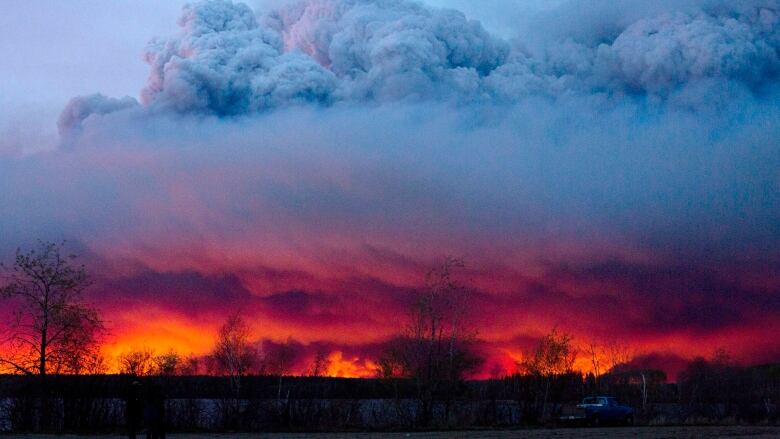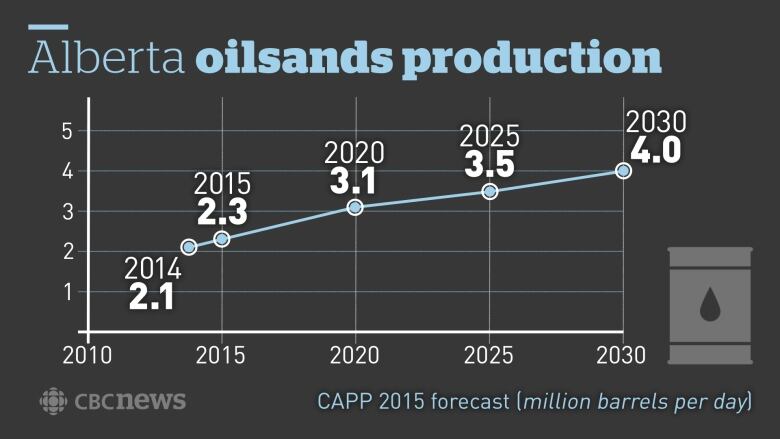Wildfire could cut oilsands production in half
Reductions could amount to 1.4M barrels per day

Several oilsandscompanies are shutting down their operations asthewildfire around Fort McMurraydraws closer to some facilities, reduces pipeline access and wreaks havoc on workers.
Oilsandsproduction has fallen by about one million barrels per day and could drop further.
There is for sure a tremendous amount of uncertainty.- Samir Kayande, ITG Investment Research
About 1.4 million barrels per day (bbl/d)is produced in thearea close to the fire, according to Samir Kayande, withITG Investment Research in Calgary, which represents more than half of all oilsands production.
Several pipelines are not operating as a precaution.
"Without pipes running, it seems reasonable that a large proportion of that or all of that is subject to being shut-in over the next few days," he said.
- Fort McMurray fire has economists cutting growth forecasts for Canada
- Oil prices jump because ofFort McMurray wildfire
Athabasca Oil'sHangingstoneoperationis justfive kilometres away from the fire. Given the safety risk tothe 70workers on siteand the potential risk to the facility, the company decided to evacuate and shut down the plant.

Massive disruptions
Suncor Energy has shut down all of its operated oilsands facilities in the region, taking upwardof 600,000 bbl/d of production capacity offline.
The company cited several reasons, including a lack of diluent, which is used to help the movement of bitumen in pipelines.
Suncor is using four of its planes and four aircraft from WestJet to help with evacuation efforts in the region.
"I'm pleased we're able to continue assisting with the safe movement of thousands of people out of the region," said Suncor CEO Steve Williams in a statement.
Other oilsands production cuts:
- Shell Albian Sands (about 255,000 bbl/d).
- Nexen Long Lake (about 40,000 bbl/d).
- ConocoPhillips Surmont (about 50,000 bbl/d).
- Imperial Oil Kearl (unknown).
- Syncrude(unknown).
Considering the unpredictability of the wildfire, it's not clear how long companies will have to curtail production. Certain producers with SAGD facilities (steam-assisted gravity drainage) must keep the bitumen underground heated, or else they risk losing production in the long run.
"There is for sure a tremendous amount of uncertainty," said Kayande."If the wind shifts and the fire burns itself out, and assets are not endangered, then you can get up and running relatively quickly. For the SAGD operations, the sooner the better. You don't want to lose the heat that's been put in the reservoirs."
Oilsands companies are acting on their emergency responseplans. Many of the facilities have emergency crews on site and have runways to help with evacuations.
Canadian Natural Resources' Horizon oilsands site, for instance, has anemergency response team that offers fire prevention, fire protection, medical and rescue response,industrial firefighting andaircraft rescue services. Two of the company's firefighting crews are assisting the provincial government's efforts in battling the wildfire.
Economists estimate themassive disruptions inoilsandsproductionwill affect the Canadian economy.












_(720p).jpg)


 OFFICIAL HD MUSIC VIDEO.jpg)
.jpg)



























































































